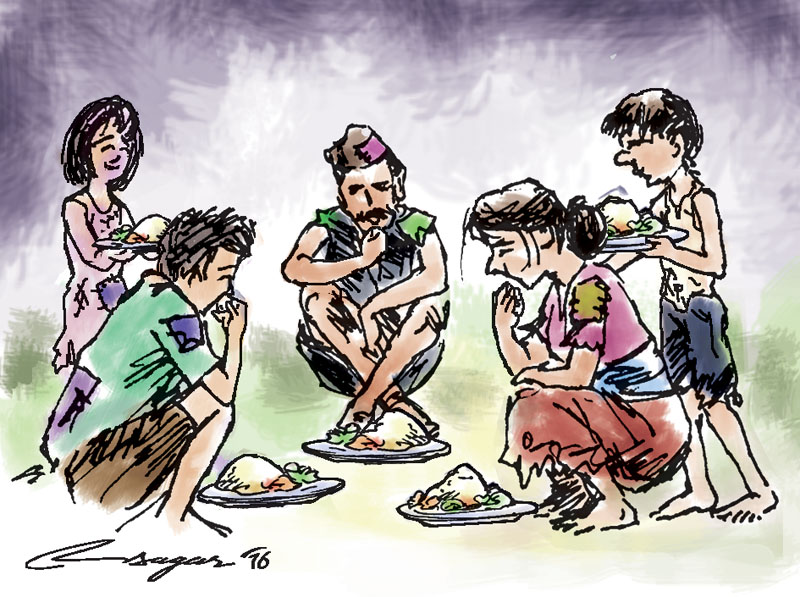News Highlight
The recent release of the NFHS data for 2019-21 allows for a detailed analysis of the progress in reducing absolute poverty and related determinants like nutrition.
Key Takeaway
- Poverty declined between 2011-12 and 2017-18 or 2019-20.
- This is because policymakers and academics have prioritised the poverty-reducing properties of inclusive growth rather than growth per se.
Poverty facts from 2005 to 2011 (P-1) and 2011 to 2021 (P-2)
- Poverty downturn
- NFHS estimates emphasise that poverty fell sharply after 2011 based on these two periods, i.e. P-1 to P-2.
- Depiction
- Multidimensional poverty declined at a compounded annual average rate of 4.8 per cent per year in P-1 and more than double that pace at 10.3 per cent a year during P-2.
- Demographic and Health Surveys (DHS) nutrition index
- The Demographic and Health Surveys (DHS) nutrition index improved at a 2.5 per cent rate during 2005-11 and more than five times faster during 2020-11.
National Family Health Survey (NFHS)
- About
- The NFHS is a large-scale, multi-round survey conducted in a representative sample of households throughout India.
- History
- The NFHS-1 was conducted in 1992-93.
- The NFHS-2 was conducted in 1998-99 in all 26 states of India.
- Conducted By
- The Ministry of Health and Family Welfare has designated the International Institute for Population Sciences(IIPS) Mumbai as the nodal agency for providing coordination and technical guidance for the survey.
- It provides state and national information on
- Fertility
- Infant and child mortality
- The practice of family planning
- Maternal and child health
- Reproductive health
- Nutrition
- Anaemia
- Quality of health and family planning services.
- Funding
- The funding for different rounds of NFHS has been provided by United States Agency for International Development (USAID), the Department for International Development (DFID), the Bill and Melinda Gates Foundation, UNICEF, the United Nations Population Fund (UNFPA), and the Government of India.
- Past NFHS
- NFHS-1 (1992-93)
- NFHS-2 (1998-99)
- NFHS-3 (2005-2006)
- NFHS-4 (2014-2015)
- NFHS-5 (2019-21)
Poverty
- It is a state or condition in which a person or community lacks the financial resources and essentials for a minimum standard of living.
Causes of Poverty
- Population Explosion:
- The world’s population is expected to increase by 2 billion persons in the next 30 years, from 7.7 billion currently to 9.7 billion in 2050 and could peak at nearly 11 billion around 2100.
- Inefficient Resource utilisation:
- There is underemployment and disguised unemployment, particularly in the farming sector. This has resulted in low agricultural output and a dip in the standard of living.
- Low Agricultural Productivity:
- A significant reason for poverty is the low productivity in the agriculture sector. The reason for low productivity is manifold. Chiefly, it is because of fragmented and subdivided land holdings, lack of capital, illiteracy about new technologies in farming, the use of traditional methods of cultivation, wastage during storage, etc.
- Colonial Exploitation:
- The British colonisation and rule over India for about two centuries de-industrialised India by ruining its traditional handicrafts and textile industries. Colonial Policies transformed India into a mere raw-material producer for European industries.
- Climatic Factors:
- Most of India’s poor belong to the states of Bihar, Chhattisgarh, Odisha, Jharkhand, etc. Natural calamities such as frequent floods, disasters, earthquakes and cyclones cause heavy damage to agriculture in these states.
Poverty alleviation initiatives
- MGNREGA:
- Mahatma Gandhi National Rural Employment Guarantee Act (MGNREGA) 2005.
- The Act provides 100 days of assured employment annually to every rural household.
- PMGKAY:
- Pradhan Mantri Garib Kalyan Anna Yojana.
- It has provided food security to the poor, needy and vulnerable households/beneficiaries so that they do not suffer because of the non-availability of adequate food grains.
- Food for Work Programme:
- It aims at enhancing food security through wage employment. Food grains are supplied to states free of cost; however, the supply of food grains from the Food Corporation of India (FCI) godowns has been slow.
Way forward
- Social mobilisation:
- Poverty can effectively be eradicated only when the poor start contributing to growth through active involvement in the growth process.
- This is possible through social mobilisation, encouraging poor people to participate and get them empowered.
- Targeted subsidies:
- The targeted subsidies would help to waste public money and spend subsidies to deserve sections of the people.
- Public investment:
- To build resilience and long-term infrastructure, which in turn help to improve economic and social development.
- Revenue mobilisation:
- the government should take measures to avoid tax evasion and improve tax collection mechanisms.
- Social investment:
- The government has to raise the spending on health and education. It helps to build strong and resilient social capital.
Content Source: Indian Express



